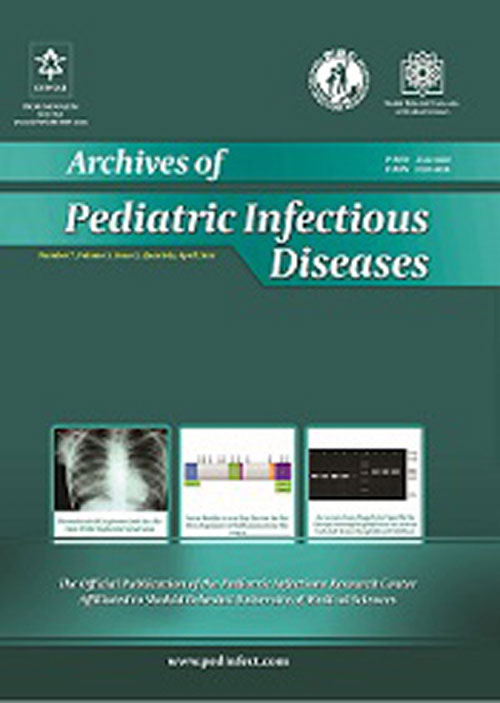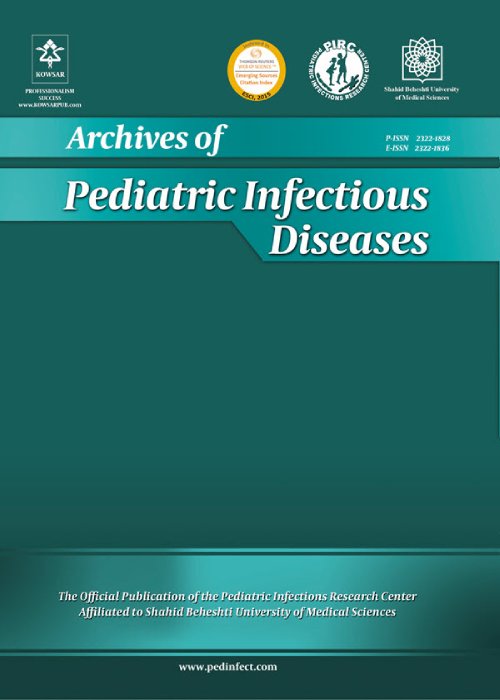فهرست مطالب

Archives of Pediatric Infectious Diseases
Volume:3 Issue: 2, Apr 2015
- تاریخ انتشار: 1394/02/03
- تعداد عناوین: 11
-
-
Page 1BackgroundParasitic invasion of tissues can elicit hypereosinophilia. Among helminthic infections, moderate to severe eosinophilia can be seen in toxocariasis as a pathophysiological response to a worm infection..ObjectivesThe current study aimed to compare the rate of toxocariasis in normal and hypereosinophilic individuals in Shiraz, southern Iran..Patients andMethodsSerum samples of 100 patients with hypereosinophilia (> 10%) and 100 normal individuals (without eosinophilia) were collected. Demographic information of the participants was recorded in a predesigned questionnaire during sample collection. Anti-Toxocara antibodies in the subjects’ serum were evaluated by an ELISA..ResultsIn the hypereosinophilic patients, 54 (54%) were male, and 46 (46%) were female, while in the normal individuals, 58 cases (58%) were male, and 42 (42%) were female. The differences in gender and age of the participants were insignificant (P = 0.46 and 0.59 respectively). Range of eosinophilia found in the patients was between 10-77%. Anti-Toxocara antibodies were detected in the serum of 2 (2%) of the hypereosinophilic patients and 3 (3%) of the normal individuals. No significant correlation was found between hypereosinophilia and the presence of anti-Toxocara antibodies in this study (P = 0.65)..ConclusionsHypereosinophilia may be due to a variety of reasons and toxocariasis is just one of these. Appropriate tests should be carried out on patients in order to rule out a Toxocara infection in hypereosinophilic individuals..Keywords: Toxocara, Prevalence, Iran
-
Page 2IntroductionFamilial Mediterranean fever (FMF) is the most common type of periodic fever syndromes. It is an autosomal recessive disorder characterized by acute, self-limited episodes of fever and polyserositis recurring at irregular intervals. Vasculitis has been frequently reported in patients with familial Mediterranean fever. The association of FMF and polyarteritis nodosa has been well established. Clinical presentation of polyarteritis nodosa in patients with familial Mediterranean fever has certain characteristics and it may be a feature of FMF itself. Herein, we report on a case of familial Mediterranean fever accompanied by polyarteritis nodosa with hepatic, renal and gastroinestinal involvement..Case PresentationA ten-year-old Iranian boy was referred to our department with history of recurrent abdominal pain followed by fever, chills, arthralgia and scrotal edema. He suffered from hematuria and gastrointestinal bleeding. His physical exam revealed fever (axillary temperature: 38.7°C), hypertension (150/90 mmHg), hepatomegaly (liver span: 13 cm), orchitis and subcutaneous painful nodules of both legs and arthritis of both shoulders and right ankle..ConclusionsMutations in MEFV gene provide a basis for the development of PAN both by forming a pro-inflammatory state and by resulting exaggerated response to infection..Keywords: Familial Mediterranean Fever, Polyarteritis Nodosa, Aneurysm
-
Page 3IntroductionGram negative bacteria including Klebsiella species are a rare cause of bacterial endocarditis in children. Klebsiella endocarditis usually needs a predisposing factor and has a poor prognosis..Case PresentationIn this study a ten-year-old boy with ventricular septal defect, who was not immune compromised and acquired Klebsiella endocarditis is introduced. The patient had a favorable response to medical treatment and underwent a successful cardiac surgery..DiscussionChildren with congenital heart disease are at risk of acquiring gram-negative endocarditis even if they have not had other predisposing factors..Keywords: Children, Klebsiella endocarditis, Congenital Heart Disease
-
Page 4IntroductionCapillaria hepatica (Calodium hepaticum) is a parasite that cause very rare but life threatening infection in human beings..Case PresentationThe current paper reports a case of Capillaria hepatica infection in a four-year-old boy which presented with fever, hepatomegaly, peripheral eosinophilia, and noticeable weight loss. The diagnosis was made on the histological finding of degenerated nematode in the liver. He improved clinically by corticosteroid and albendazole therapy..ConclusionsCapillaria hepatica should be considered in differential diagnoses in any child with fever, hepatomegaly, eosinophilia and hyperglobulinemia..Keywords: Capillaria hepatica, Hepatic Granulomatous Reaction, Parasitic Infection
-
Page 5Context: Urinary tract infections (UTIs) are among the most common infections in children that affect up to 3% of boys and 8% of girls. Delay in diagnosis and treatment causes renal injury and scars that can progress to end stage renal disease (ESRD) requiring dialysis and transplantation..ResultsThere are many pitfalls in diagnosis of UTIs both with urinalysis and culture methods and also in evaluating the risk factors and causes of UTIs..ConclusionsThis paper reviews and discusses the common pitfalls in diagnosis and evaluation of UTIs in children..Keywords: Urinary Tract Infection, Renal Disease, Diagnosis, Children
-
Page 6BackgroundOpportunistic fungi cause fungal infections. Whereas some microorganisms are resistant to chemical drugs, scientists are looking for new natural and inorganic antimicrobial agents. The recent research on metal nanoparticles showed that silver nanoparticles (nanosilver) exhibits lower toxicity to mammalian cells and higher toxicity to microorganisms..ObjectivesThis study aimed to compare the difference between antimicrobial effect of nanosilver and some antibiotic agents on Candida albicans..Materials And MethodsWe studied effect of fluconazole, nanosilver, and their combination on 20 fluconazole-resistant C. albicans from two centers and one standard sample (ATCC10261) by minimal inhibitory concentration (MIC) method..ResultsResult of fungi static and fungicidal activities of nanosilver plus fluconazole on fluconazole-resistant C. albicans showed better inhibitory effect on the growth of standard C. albicans when MIC of fluconazole (8 µg/mL) combined with MIC of Nanosilver (0.0625 µg/mL)..ConclusionsTotally, our results showed nanosilver caused an increase of at least nine-fold in inhibitory effect of fluconazole..Keywords: Fluconazole, Silver, Nanoparticles, Candida albicans
-
Page 8BackgroundNosocomial infection is one of the most important causes of neonatal mortality, especially in premature neonates hospitalized in Neonatal Intensive Care Units (NICUs)..ObjectivesThis study aimed to evaluate the incidence, main infection sites, prevalent microorganisms and risk factors related to nosocomial infection in NICU of Fatemieh Hospital in Hamadan, Iran, during 2012 - 2013..Patients andMethodsThis cross-sectional retrospective study was performed during an 18- month period (2012 - 2013) in which we evaluated the nosocomial infection in 1000 neonates hospitalized in NICU of Fatemieh Hospital in Hamadan, Iran, who survived more than 72 hours and were not transferred to other wards, till their discharge from the hospital or death, based on the National Nosocomial Infection Surveillance criteria. Data were analyzed using SPSS software..ResultsThe incidence of nosocomial infection was 5.7 per 100 patients and 7.1 infections per 1000 days of hospitalization. Blood stream infection (45.6%) was known as the most prevalent site of nosocomial infection and staph coagulase negative (56.1%) as the most prevalent organism causing the disease. Independent factors related to nosocomial infection included lower gestational age, long-term mechanical ventilation, using parenteral nutrition, delay in initiation of oral feeding and setting venous catheters. No significant difference was observed in prognoses of the disease between the two groups, but the duration of hospitalization was longer in the group of patients having nosocomial infection..ConclusionsThe results of this study show that the incidence of nosocomial infection in neonates is high and decreasing the risk factors such as prematurity, mechanical ventilation and reducing invasive procedures can decrease the infection and improve rapid recovery in these neonates..Keywords: Neonates, Nosocomial Infection, Risk Factors, Neonatal Intensive Care Units
-
Page 9BackgroundHelicobacter pylori (H. pylori) is one of the most common chronic bacterial infections world-wide and has several adverse consequences particularly on health of pediatric patients..ObjectivesThe current study addressed various clinical presentations associated with H. pylori infections among children of a rural community..Materials And MethodsIn this case-control study, the number of cases (H. pylori- positive) were 120 (52.5% boys and 47.5% girls) and the control group (H. pylori-negative) were 100 cases aged 7 - 12 years old (Mean 9.9 ± 3 years). H. pylori infection was defined by positive results for H. pylori stool antigen test and serum IgG or urea breath test. All pediatric participants were assessed for weight, height, sideropenic anemia and gastrointestinal symptoms..ResultsThe results showed that recurrent abdominal pain, recurrent vomiting and anorexia were 81 (67.5%), 24 (20%) and 15 (12.5%), respectively in H. pylori-infected patients, compared to 28 (28%), 8 (8%) and 4 (4%) in control group. Weight and height were 20.4 ± 1 kg and 128.1 ± 1 cm in case group compared to 25.6 ± 1.7 kg and 133.8 ± 2 cm in control group. Sideropenic anemia was 36.7% in patients compared to 15% in control..ConclusionsIn conclusion, the study findings revealed that pediatric H. pylori infection is associated with recurrent abdominal pain, anorexia and recurrent vomiting, also adversely affects the growth of children in various modalities; in particular weight, height and progressive incidence of sideropenic anemia..Keywords: Helicobacter Pylori, Pediatrics, Signs, Symptoms, Digestive System, Anemia, Iron, Deficiency
-
Page 10BackgroundMethicillin-resistant Staphylococcus aureus (MRSA) is one of the most important agents producing nosocomial diseases in hospitalized children. Consequently, screening of in hospital health care providers who are in direct contact with patients is necessary..ObjectivesThe aim of this study was to determine the prevalence of MRSA in health care providers, their antimicrobial resistance pattern and Staphylococcal Cassette Chromosome mec (SCCmec) typing..Materials And MethodsTwo hundred and twenty nine health care providers were examined and nasal samples were sent for S. aureus culture and sociodemographic data were obtained from them, during one year, from August 2012 to July 2013. After MRSA identification, all isolates were examined for antibiotic resistance pattern and SCCmec typing..ResultsStaphylococci were isolated from 27 samples. Twenty one of them were MRSA. The highest resistance to antibiotics was for penicillin (90.3%) and ceftazidime (77.4%). All isolates were sensitive to linezolid and vancomycin. Two isolates (9%) had SCCmec I, five (23%) had SCCmec II, nine (42%) had SCCmec III, and one (4%) had SCCmec IV. Four isolates were nontypable by using the published primers, perhaps indicating the existence of a novel SCCmec class..ConclusionsCarrier samples screening is considered inferior to clinical samples. Treatment of a variety of infectious diseases is difficult due to resistant bacteria. Consequently, annual screening of these individuals, detecting the carriers and decolonizing them to reduce transmission of S. aureus in the hospital are necessary..Keywords: Methicillin, Resistant Staphylococcus Aureus, Health Care Providers, Drug Resistance, Microbial, Child, Hospitalized


